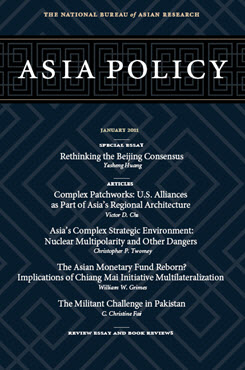Complex Patchworks
U.S. Alliances as Part of Asia's Regional Architecture
This article examines the significant role of existing U.S. bilateral alliances in the complex interplay of emerging regional security architectures in Asia.
EXECUTIVE SUMMARY
MAIN ARGUMENT
The continued relevance of the U.S. bilateral alliance system in Asia appears most tested by questions of regional architecture. International relations and areas studies scholars have rushed to a judgment that the alliance system is failing both to think creatively about regional architecture and to integrate China’s rise in Asia. The future of security cooperation in the region, however, may not be as dim as people surmise. This article argues that a definite architecture is emerging and evolving in Asia that the U.S. and its allies support. This architecture is not dominated by China, nor is it characterized by U.S. diminution; rather, it is inclusive of the major powers in the region. Nonetheless, this regional architecture must overcome a clear security dilemma to realize its positive potential. The dilemma is that U.S. alliance–initiated regional efforts are seen as latent efforts to contain China, while regional- or China-initiated proposals are seen as attempts to exclude the U.S. By encouraging a fluid network of security architecture, however, this problem can be mitigated to avoid zero-sum solutions. The picture of the institutions that connect the U.S., its allies, and China in the region is much more complex than bilateral vs. multilateral. Instead, this architecture is a “complex patchwork” of bilaterals, trilaterals, and other plurilateral configurations. The complexity of this geometry is a useful tool for muting regional security dilemmas.
POLICY IMPLICATIONS
- The U.S. bilateral alliance architecture is an integral component of Asia’s emerging regional architecture.
- The emerging Asian architecture, composed of bilateral, trilateral, and other multilateral relations, is fluid and results-based; it is not a single overarching institution like that found in Europe.
- The U.S. and China are both able to operate within this architecture to achieve positive-sum gains.
About Asia Policy
Asia Policy is a peer-reviewed scholarly journal presenting policy-relevant academic research on the Asia-Pacific that draws clear and concise conclusions useful to today’s policymakers. Asia Policy is published quarterly in January, April, July, and October and accepts submissions on a rolling basis. Learn more


